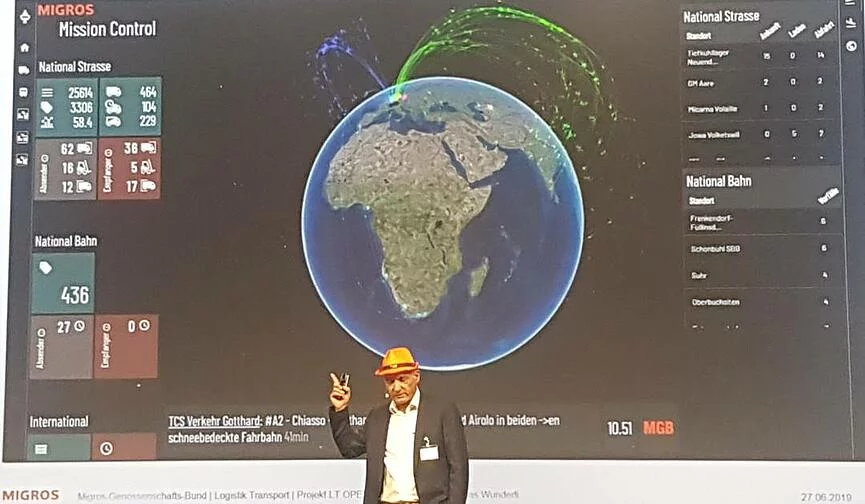
Trends in the retail logistics industry
A recap from the Austrian logistics day in Linz
Last month the Austrian logistics day 2019 (“Logistiktag”) took place in Linz. Nicely located near our headquarters in Leonding, experts from our product team dropped by to get in touch with innovation leaders in the logistics industry.
There certainly is a lot happening in the field of logistics, as the next wave of the digital transformation movement is poised to change the way products are being moved, distributed and delivered. The most significant changes are likely to happen in areas, where the customer won’t take immediate notice of them. Robots in warehouses, automation in distribution networks etc. – all these changes impact the consumer experience only indirectly, for example through reduced delivery times.
Which trends are most likely going to transform the world of retail logistics? Here are our picks:
Trend #1 - Platforms
Platforms are a dominating trend in the IT industry and a central aspect in the emergence of a fully realized digital economy. They form a bridge between supplier and consumer and take on a position in the space between the customers and the providers of products and services.
This general shift is also tangible within the logistics industry, where platform-based business models are gradually replacing product-driven business models. The possible fields of application are plenty and there is a lot of potential for disruptive offers, even in B2B scenarios. Platform-based solutions in logistics mostly make a case for optimization in typical supply chain scenarios like reducing empty runnings or unused storage.
Platform providers with a regional focus (e.g. in Europe where they need to balance a wide variety of legal regulations) might start to capitalize on opportunities created by transferring successful practices to other regions.
Trend #2 - Digital signage and digital price tags
The demand for digital signage solutions has seen quite a surge recently. Digital price tags especially, which come equipped with technologies like E Ink, Bluetooth and NFC, are increasingly popular options. Digital signage solutions are an important driver in bringing aspects that customers appreciate about e-commerce (like tailored offers or live product information) to the world of brick and mortar retail.
From a logistics perspective, digital price tags could be used to display live stock levels. Using NFC on price tags to check which products spark most interest (e.g. by measuring how often a given tag is scanned) could be an option in order to create more accurate demand forecasts. With the capability to adapt prices, digital price tags could be used to run ad hoc promotional campaigns. The potential rise in demand could then be considered while calculating replenishment forecasts as well.
Following a similar approach, digital signage solutions in or around the store could be enhanced with tracking capabilities to measure the amount of attention specific pieces of content receive. The results could then be incorporated into predictions to help optimize the supply chain.
"While robots are dominating the warehousing industry, they have almost no role to play in retail operations"
Trend #3 - Robots in retail logistics
Robots have become an integral part of modern warehouse operations, effectively enabling the massive popularity of e-commerce and the associated challenges that come in tow with offers like same-day delivery. While robots are dominating the warehousing industry, they have almost no role to play in retail operations. One particularly interesting use case came from MetraLabs. Their robot TORY, which is equipped with a navigation system and an RFID scanner, roams the store during the night, scanning RFID articles and taking inventory. This way, store managers receive a daily update on the stock levels, which is both accurate and up to date every morning.
Which impacts will we see in telco retail?
Telco retail thrives on information-driven interactions and personalized offers. Customers are addressing telcos with high expectations, perhaps more so than in other industries. Products and services need to be accessible, intuitive and priced transparently. While passionate employees are highly effective at delivering a great customer experience and their dedication is invaluable in the process, technology still needs to be put in place to make keeping up with customer demands for them as simple as possible.
Logistics will continue to play a crucial role in retail: The right items need to be in stock and delivery times should be kept at a minimum. This is where advances in technology are likely to have an impact. At the end of the day, customers will flock to wherever they see their expectations met in the best way possible.
Best practices in retail transformation - learn how Spark did it
In a recent project, we helped New Zealand telco Spark to drive their digital transformation campaign forward by implementing our suite of retail management and enterprise stock management solutions. Read our case study to learn the detail about this project.
Interested in receiving regular updates on product developments and best practice in digital business transformation for telcos? Follow us on LinkedIn and Twitter to keep up-to-date on NTS Retail!


